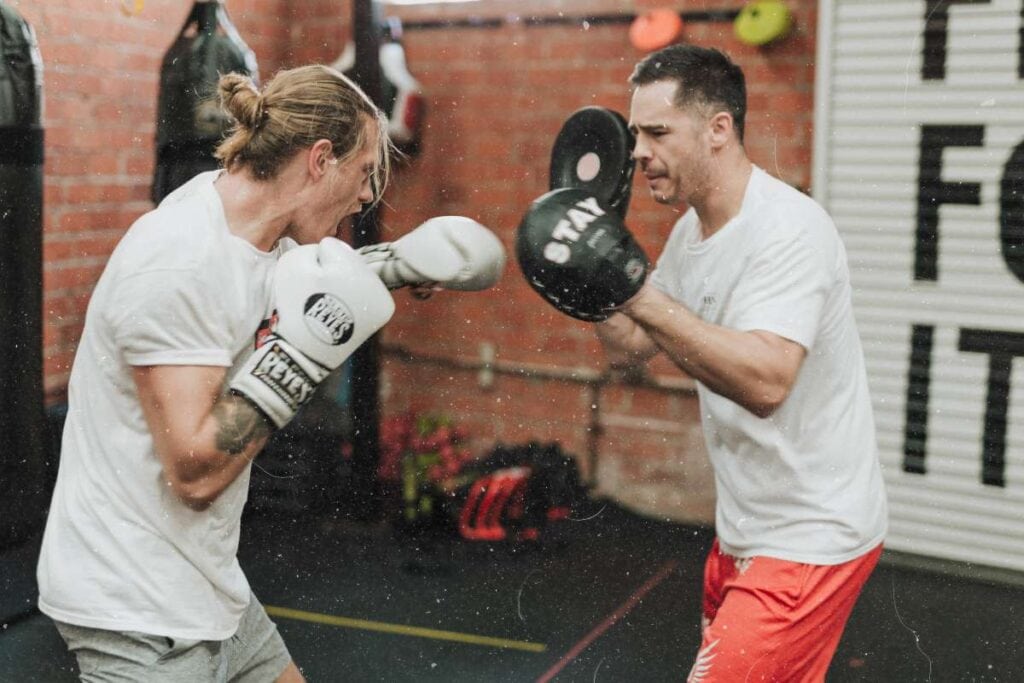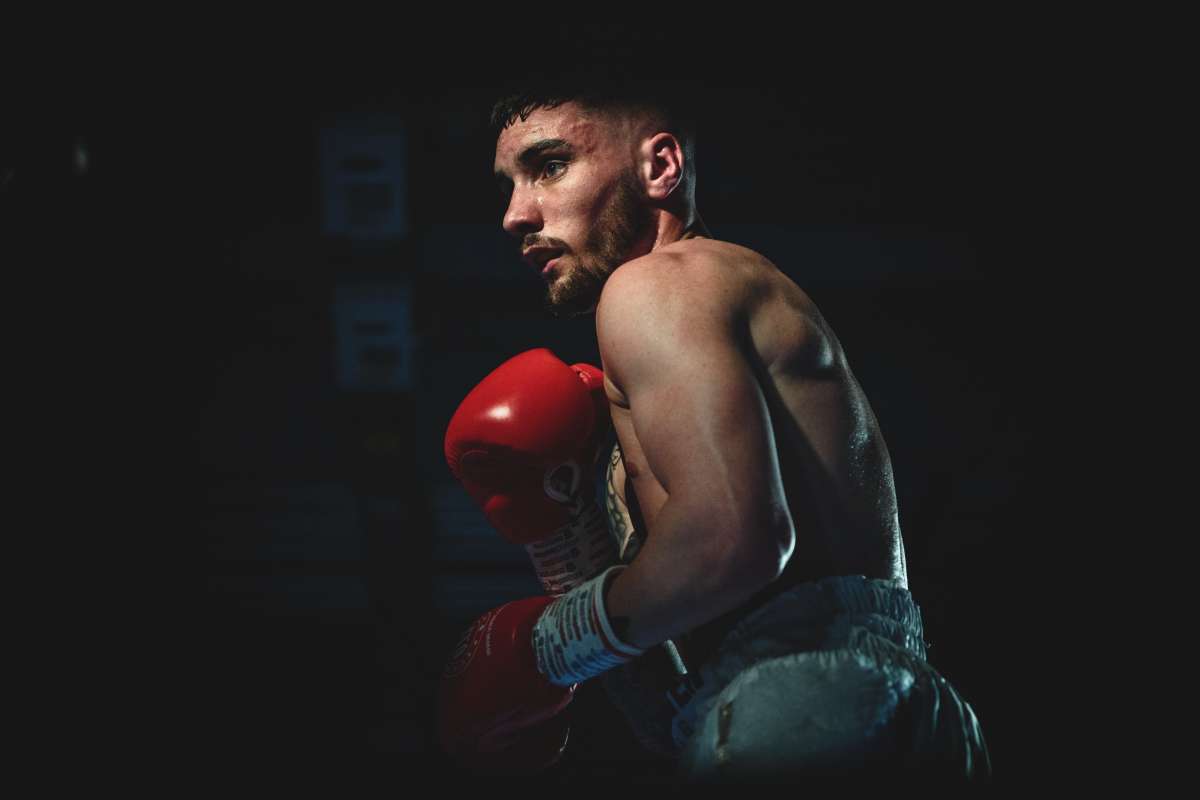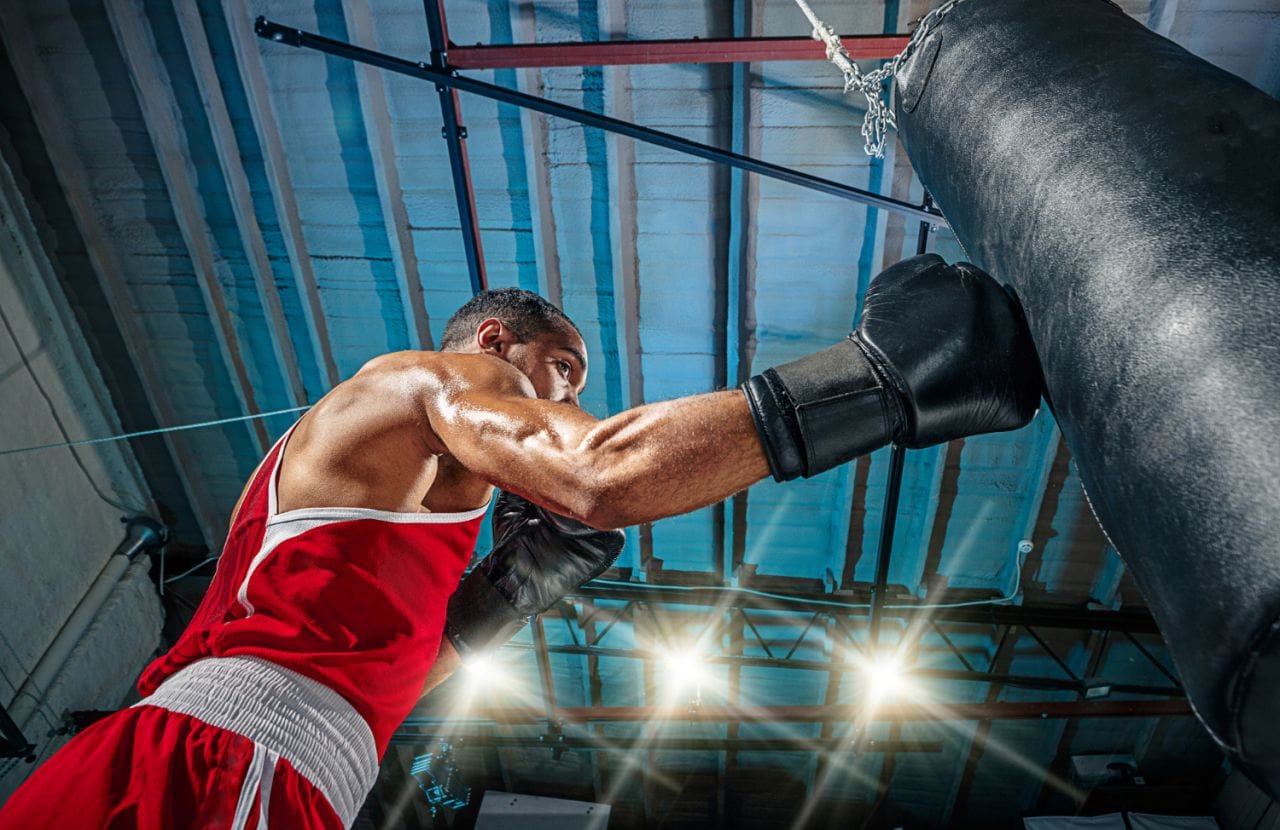It’s an incredibly fun way to stay fit. Boxing training, or boxercise, is a full cardio workout that keeps your muscles toned and your body in shape.
Each training session improves your strength and stamina whilst perfecting the technique.
Boxing can be practised alone at home, with a training partner, or in groups at your local gym.
If you're like most people, you may be wondering what the benefits of boxing are. After all, it can seem like a pretty intense sport! But the truth is, boxing has a lot to offer anyone interested in getting fit and improving their overall health. In this blog post, we'll take a closer look at some of the key benefits of boxing and explain why it's such a popular fitness choice. So keep reading to learn more!
Boxing FAQs
There are four generally accepted boxing styles that are used to define fighters. These are the swarmer, out-boxer, slugger, and boxer-puncher.
The terms pugilism and prizefighting in modern usage are practically synonymous with boxing, although the first term indicates the ancient origins of the sport in its derivation from the Latin pugil, “a boxer,” related to the Latin pugnus, “fist,” and derived in turn from the Greek pyx, “with clenched fist.” The term ..
It's not just physical exhaustion, but also the mental concentration required in boxing. It's the willingness to confront not only your opponent, but also your own fear. That reason, fear, as ESPN indirectly pointed out, is the reason more than any other that boxing is the most difficult sport.
Is it legal to punch arms in boxing? Punching your opponent's arms and shoulders in boxing is perfectly legal. The areas of the body that you are unable to hit include: below the belt, neck, kidneys, the back of the head, and the back of the body.
You cannot punch your opponent's back, or the back of his head or neck (known as a rabbit punch) or in the kidneys (kidney punch).
What Kit Do You Need To Start Boxing?
There are several must-haves for boxing, those accessories that you should never walk into a session without if you want to keep everything in working order. The good thing is these little pieces of kit are cheap, affordable, and easy to get hold of. So what are they?
Mouthguard
Although a few things might be provided for you in the early stages of joining a boxing gym or boxercise class, a mouthguard is not one of them, and you should never practice boxing without one.
Made to protect your gums and teeth and reduce the risk of mouth lacerations, mouthguards must be tailored to the shape of an individual’s teeth to maximise protection.
If you're buying a standard mouthpiece, you will need to boil up some water and let the mouthguard soak for the time noted in the instructions. When the time is up, remove the mouthguard and run it under cold water for two seconds, then place it into your mouth. You must then bite down lightly and press the mouthpiece around your gums with your fingers. Once complete, you have your mouthguard tailored for your training needs.
Hand Wraps
If one area of the body is more prone to injury than any other in boxing, it's your hands and wrists. Whether you're punching a bag, pads, or an opponent, your hands are constantly impacted, so it's important to have something in place to eliminate the risk of bone fractures. This is where hand wraps come in.
Hand wraps are similar to a thin bandage and wrap around your wrists and knuckles to support weight at the point of impact. They come in various lengths depending on the size of your hands and are worn under your gloves during any session that involves punching.
In general, most boxers will apply hand wraps before any session, whether they're skipping, doing circuits, or shadow boxing, to stay in good habits. There is, however, a specific way to apply wraps, which is easy to learn and important to get to grips with from the get-go.
Boxing Gloves
A good pair of gloves is essential if you want to box, and with so many different weights, constructions, and price points, it can be easy to get a little lost when starting, and you can end up lumbered with a pair of gloves that aren't right for you. Boxing gloves are there to protect your hands from impact further whilst also lessening the damage to your opponent at fight level.
When choosing a pair, you need to consider two things:
Whether or not you will be sparring (full contact training)
Your Weight
To make things a little easier, we've put together a boxing glove comparison chart (below) to get the right type of gloves for your size and weight. Of course, the heavier you are, the bigger gloves you will need to protect your hands from a more intense impact. Boxing gloves are generally weighed in ounces.
Choosing the correct boxing glove weight:
- 40-50kg = 8oz
- 50-59kg = 10oz
- 60-74kg = 12oz
- 75-86kg = 14oz
- 86-plus kg = 16oz
What Extra Kit Might You Need?
Besides the three essentials to get you started, there are also a couple of other items that will help out at the beginning depending on the type of training you're going for. So whether you're looking to train from home or eventually get into full contact sparring, these items could help you on the way.
Boxing Headgear
If you're going to spar regularly, investing in your head guard is wise. Yes, boxing clubs up and down the country provide this type of kit, but it can get overused and leave you exposed, so buying your own that fits your head perfectly is a step in the right direction.
Headguards are there to cushion the impact when involved in a full-contact situation with an adversary. It's imperative that your head guard doesn't impede your vision (for oncoming headshots) and fits snuggly on your head. A loose head guard risks causing injury and losing sight of your opponent. On the other hand, an overly tight head guard can restrict blood flow and affect your alertness and overall performance.
Boxing Shoes Or Footwear
Many people starting in boxing can get away with a pair of normal trainers or runners, so long as you can remain nimble on your feet. If you do catch the boxing bug after a while and want to start working out at the next level, and train more effectively at home or in the gym, grab a pair of boxing shoes.
Attack and defence in boxing start and end with your feet as you move in and out of striking distance. Directional changes and balance are a huge part of the sport, and the risk of rolling your ankle is an ever-present danger.
Boxing boots are not only light with a good grip for both hard and soft surfaces, but they also lace up to the lower part of your leg, helping keep your ankles supported and in the right position. Like hand wraps, many boxers will put on their boots when they enter the gym doors, although proper trainers should be used for any long-distance runs pre-workout.
Punching Bags
A big step for any aspiring boxer is to get a punching bag hung up in the garage or a spare room so that you can get some rounds in at home. This is a highly practical way to train those who work odd hours and can't always make it to classes.
Before grabbing the first bag, you come across; you'll want to keep in mind a few things so that you get the best out of your purchase. Will you be using the bag solely for western boxing (hands only), or would you like to eventually practice kickboxing, muay Thai or MMA that involves using your legs and knees to strike.
If it is just straight-up western boxing, you will be better off with something like a PB 850 Punching Bag or PB 1000 Punch Bag, bags with a bit of weight that represent the upper torso of an opponent. If you want to start using your legs eventually, then a longer bag like the PB 1500 Leather Bag or a Tilting Bag will keep you right. Like this, you can practice your punches and knees in both the low and high range.
Skipping Ropes
Walk into any boxing gym up and down the country, and most training sessions will start with either a light run before skipping or vice versa. An adjustable skipping rope is super cheap, great to get your heart rate up before any type of session, easy to store, and you can use it anywhere.
It's also a great way to get your wrist and ankle muscles in shape and build those all-important calf muscles, as good boxers spend a lot of time on their toes. Having your rope that you become accustomed to and adjusting the length to suit your height will result in longer, more sustained skipping and better overall fitness.
If the chord is too long or too short, a skipping experience can quickly become frustrating. They come in both rope and leash form, the latter being more prevalently used by the boxing community thanks to durability over time.
Safety Tips For Beginner Boxers
Boxing as a sport is renowned for its risks, but practising it regularly needn't cause injury if you take the right precautions.
What Are The Most Common Injuries In Boxing?
Sprains
Sprains are painful. They can put you out of training for a while and even affect your day job depending on what you do. The three main areas susceptible to sprains are your ankles, wrists and thumbs.
As boxing involves a lot of directional changes, rolling your ankle can easily cause a sprain. This can be avoided with a good pair of boxing boots that add support to your ankles. Also, your thumbs and wrists are exposed when you’re on the punch bags, so hand wraps and closed thumb boxing gloves will go some way to help avoid injury.
Concussion
Any sport that involves head impact will have an element of concussion risk. A concussion is very serious, and repeated concussions can lead to permanent brain damage. However, avoiding it when practising boxing is simple. You either wear a head guard, which offers added padding during sparring or avoids sparring altogether.
Cuts And Bruises
As boxing is a full-contact sport, you can expect plenty of cuts and bruises, even more so in disciplines such as Muay Thai, where you use your legs to block, along with knees and elbows to strike. Choosing the correct safety equipment, such as leg pads, head guards and gloves, will go some way to help you avoid any major cuts and heavy bruising.
Fractures
Hand and nose fractures are the most common in any boxing. The nose is a sensitive part of the body, and an opponent will always aim for it. There is very little protection other than just ducking and moving out of the way, so working on your defence is key to avoiding nose strikes.
Hand fractures come from high impact punching. In most cases, when you are working out at your local gym or home, hand wraps (applied correctly) and boxing gloves keep you free from breaks. It is often more intense real-fight situations that cause serious fractures.
If you have fragile hands due to an old injury, take advice from your doctor before boxing.
Best Ways To Avoid Injuries In Boxing
Performing A Good Warm-Up
Like any physical activity, boxing requires a thorough warm-up. In general, your coach or trainer will have you skipping before any session. Skipping requires movement on your toes, much like a boxer in the ring, and rotation of the wrists, which are the foundations of any good punch.
Once you have done 5-10 minutes of skipping, it's wise to go for a short run to get your heart rate up whilst working your lungs. A run doesn't have to be over a huge distance. Between 2-3 km is fine. Just make sure it's not a doddle and put in some real effort.
Using Basic Protection
After you have warmed up, chances are some point; you will get onto the pads. However, before undertaking any pad work, bag work or sparring, you will need a few essential pieces of kit.
Full Contact And Sparring Safely
The biggest chance of injury in boxing comes when you go head to head with an opponent, whether it is someone at your gym or an adversary in a full-contact contest. A few parts of the body need extra protection, so you will need to consider the following.
Groin Protection
Also known as a box, groin protection is made to keep your lower regions free from stray hooks. They can also add padding to your lower stomach, and it is boxing law that any amateur or professional fighter in an official contest must wear one.
If you are practising Muay Thai or kickboxing, your groin protection will be a lot smaller to free up leg movement for kicks and blocking, so be sure to buy the right one for your respective discipline.
Face Protection Jelly
When you see a boxer or MMA fighter on the TV, they shine under the lights. But this is not to make them look better; it's actually to cause their opponent's shots to slide off their face and body. Petroleum jelly or vaseline is generally applied before a contest and between rounds. Be mindful that if too much is put onto your face or body in an official contest, a referee will point you back to the corner to remove the excess.
Heat Liniment
There is a lot of stretching when kicking and blocking in kickboxing, and in Muay Thai, well-applied heat cream to the legs can help avoid muscle strains. In a full combat situation, fighters will also apply this to their arms and torso.
Where To Practise Boxing
Even though there are many opportunities for practising boxing, you will need an introduction to the sport’s fundamentals.
Boxing Gym
The boxing gym is always the best place to start boxing; the boxing gym is full of people passionate about the sport who will be happy to show you the basics. As footwork, power and hand speed are key to progressing within the discipline, a good trainer will have you moving like a pro after a few sessions.
Boxing gyms are also full of seasoned boxers and even the odd professional, so you can get tips by watching others work the pads and bags. In general, a gym is cheaper than studio classes such as boxercise, and the training is similar to that of a fighter preparing for a full contact bout.
Sparring is optional and usually takes place on set days so that participants don’t feel pressured to fight one-on-one. A standard session at a boxing gym lasts around 2 hours and is a mix of cardio training and boxing technique.
Boxercise Classes
Boxercise is about fitness and stamina, a great cardio workout based on boxing without any actual one-on-one combat. It’s easy to pick up and is less skills-focused than a boxing gym workout. It’s also a great way to participate in a class with a friend, a partner, or just on your own.
There is generally much pad work involved with intense 2-3 minute circuits with short 30 second intervals, just like boxing rounds. Boxercise classes are generally available at leisure centres, local gyms, and sports halls. Some even offer boxercise classes that involve kickboxing and Muay Thai techniques for the more elegant and adventurous.
Reasons Why You Should Try Boxing (All Benefits Of Boxing)
Fat Loss
The boxing workout is great for fat loss. Almost every boxing exercise will make you sweat. If you’re doing heavy bag work, mitt work, jumping rope, sparring, push-ups or even shadow boxing, you’re going to burn calories.
You can lose 3-4 pounds in a single workout if intense enough, which is much more than a regular workout in the gym, even if you do mainly cardio exercises.
Self-Defence
Many sports can help you defend yourself. But we think boxing is the most effective, especially when facing more than one attacker. Because when fighting with multiple attackers, the last thing you want is to get the fight to the ground. Because if one of your opponents manages to take you down, the others can start kicking you or smash you.
So combat sports such as wrestling or BJJ are ineffective in such situations. Even kickboxing can be ineffective because opponents can catch some of your kicks and take you down. On the other hand, boxing teaches you to defend yourself in a standup position using only your hands, head movement and footwork.
And if you don’t want to hurt your attacker, you can defend yourself by simply blocking the shots and using your footwork to create a distance until the aggressor exhaust himself.
Improving Reflexes
Boxing requires good reflexes and timing. You need those skills no matter if you’re trying to land shots or trying to block or slip punches.
At first, you probably won’t have great reflexes, but you will improve them over time. The speed bag and the sparring are the best way to do that. You will see the difference after just a few workouts.
Increasing Your Strength
Although it’s not necessary to be strong to be a good boxer, you will probably gain some strength while training for boxing.
Especially when doing exercises such as weighted shadow boxing, push-ups, pull-ups or medicine ball throwing.
Physical Toughness
Every time we finished the sparring, our coach always told us to do abs conditioning. And that was punching each other in the abs (with roughly 60% power) for 30 seconds.
Such exercises make you physically tougher and more durable.
Speed
You’re not going to improve only your hand speed if you start boxing. You’re going to be much faster with your footwork and your head movement. Boxers do exercises such as sprinting, footwork drills, speed bag work, and double-end bag work to improve their speed.
Coordination And Body Awareness
By training for boxing, you will improve your eye-hand coordination and body awareness (understanding of where the limbs are in the space). And that can be helpful not only in other sports but also in your daily life.
The best boxing exercises to improve your coordination are shadowboxing, jumping rope, footwork drills and speed bag work.
You’ll Start Feeling More Confident.
The ultimate goal of combat sports/martial arts is not having to use them. After you gain some experience in boxing and become aware that you can hurt other people, you will become much more confident. Still, you will also try to resolve conflicts peacefully.
Also, you’ll start feeling and looking better because you’re working out regularly, which will also boost your confidence.
Boxing Boosts Your Stamina
Having good stamina is crucial when it comes to boxing. The pros have to box for 12 rounds, 3 minutes each. That’s 36 minutes of throwing punches, defending and moving (and even grappling in the clinches). Also, consider that they are in a stressful situation, so they gas out even quicker.
That’s why boxers focus so much on their cardio by doing exercises such as running, sprinting, swimming, jumping rope, etc.
When Doing Boxing, You Train Like A Real Athlete
Boxing is about attacking and defending at the same time. That’s hard and requires different skills and abilities. That’s why boxers do so many exercises for conditioning (push-ups, sit-ups, running, swimming, jumping rope, etc.).
When training for boxing, you do all these drills to feel the intensity of a real athlete's workout.
You Can Choose Your Level
It’s unnecessary for all people who start boxing to become pros or even compare in amateur bouts. You can decide if you’re going to box to get into shape, lose some weight, or for a living. You can choose your level of involvement – do you want to train 2-3 times per week, or do you want to train almost every day and someday maybe even compete?
The Bottom Line
Boxing training is a form of exercise that involves footwork, punching, and evasion movements to simulate the activities involved in boxing.
It’s often combined with other conditioning activities, such as jumping rope and callisthenics, which increases the intensity of each training session.
Boxing can help improve your heart health, body composition, and strength, lower your blood pressure and aid weight loss.
Most of all, boxing is a fun way to get some exercise and release stress safely and healthily.



